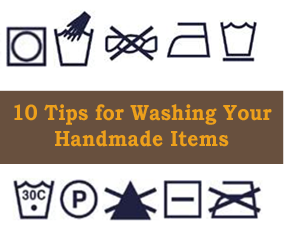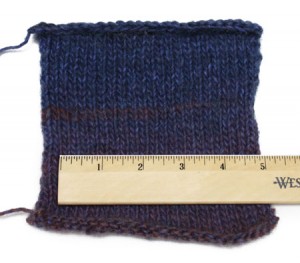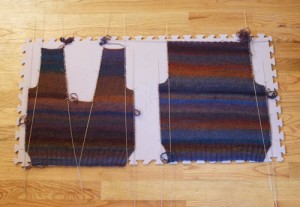
There was a time when I did laundry and the most sorting I would do for my loads would be to separate the whites and colors. I washed everything in hot water, and threw them all into a hot dryer to dry. Needless to say, my cashmere sweater was no longer a recognizable garment. It shrunk incredibly and had multiple holes in it; that sweater was dead. Thankfully it wasn’t a hand-made item, but it still hurt to lose it – so today, I’ll share some tips on how to properly wash those yarn-crafted goods that you spent your precious time and energy on.
- Check Your Label: The ball band will indicate with symbols, and in text how to wash and dry the yarn. There will also be a symbol indicating whether or not you may iron the fabric. (When gift giving, it’s best to give the care label with some scraps of the yarn attached to the intended recipient).
 Test Your Gauge Swatches: Another reason to gauge swatch! Not only do you want to make sure your gauge is correct, but you want to see how the fabric reacts when it’s washed. Note your initial swatch measurements, then take note of any size, color or textural changes after washing it (if applicable).
Test Your Gauge Swatches: Another reason to gauge swatch! Not only do you want to make sure your gauge is correct, but you want to see how the fabric reacts when it’s washed. Note your initial swatch measurements, then take note of any size, color or textural changes after washing it (if applicable).- Hand or Machine Wash?If the label says hand wash, hand wash the fabric! If you throw it in the washing machine, you might damage your final piece. If it’s machine washable, keep it on a low, gentle setting (also to ensure your weaved ends stay in place).
- Choose the Right Detergent: You want to use a gentle detergent with your hand-knits, and use it sparingly. This is especially important when it comes to washing wool; you can find special detergents such as Soak or Eucalan, which are both eco-friendly, gentle detergents that don’t need rinsing.
- Water Temperature: Your knitwear should be washed in cool to lukewarm water as to avoid felting or pilling. Don’t wash your wool in hot water! It will shrink and felt, becoming a completely different item. Extreme cold or hot temperatures could negatively affect the fibers.
- Wet Fabric Support: Fibers behave a lot differently when wet so make sure you don’t rub or squeeze your fabric. If you need to get a stain out, blot the wet area, but don’t rub the pieces of fabric together to get it out.
- Color Care: It’s normal for some yarns to bleed a bit, especially if they’re hand-dyed. Again, look for any special care instructions indicated on your yarn label, especially if a skein seems to be a highly saturated color. Wash your fabric in cool water and swish it around in the sudsy water; stay away from hot/warm temperatures, and wash like colors together. Rinse in cool water.
 Blocking: If this is your first item, you can combine your blocking/washing session together. If you’ve blocked the garment before, it doesn’t hurt to re-block after washing, ensuring that your project keeps it’s shape longer. Most people block by pinning their items on to blocking boards in the desired finished shape.
Blocking: If this is your first item, you can combine your blocking/washing session together. If you’ve blocked the garment before, it doesn’t hurt to re-block after washing, ensuring that your project keeps it’s shape longer. Most people block by pinning their items on to blocking boards in the desired finished shape.- To Spin or Not to Spin: Some yarncrafters spin their items in a washing machine after the rinse cycle on a low setting; this is fine, but never wring your items, especially if they’re soaking wet. Another option is to place your item in between two towels, roll up the towels and press gently, so that the towel absorbs most of the water.
- Drying Process: You’ll find a lot of labels indicate to “lay flat to dry”, especially when it comes to all natural fibers. Don’t hang the item because they will stretch, and if on a hanger, they’ll take on the hanger form. Reshape your garment during drying intervals, and avoid leaving the piece in direct sunlight so that it doesn’t fade the color. Be sure to change your towels while drying! You don’t want your piece sitting on the same wet towel for hours.
Do you have any other yarn care tips worth mentioning? Share your insights in the comments.
Related Links:

 Test Your Gauge Swatches: Another reason to gauge swatch! Not only do you want to make sure your gauge is correct, but you want to see how the fabric reacts when it’s washed. Note your initial swatch measurements, then take note of any size, color or textural changes after washing it (if applicable).
Test Your Gauge Swatches: Another reason to gauge swatch! Not only do you want to make sure your gauge is correct, but you want to see how the fabric reacts when it’s washed. Note your initial swatch measurements, then take note of any size, color or textural changes after washing it (if applicable). Blocking: If this is your first item, you can combine your blocking/washing session together. If you’ve blocked the garment before, it doesn’t hurt to re-block after washing, ensuring that your project keeps it’s shape longer. Most people block by pinning their items on to blocking boards in the desired finished shape.
Blocking: If this is your first item, you can combine your blocking/washing session together. If you’ve blocked the garment before, it doesn’t hurt to re-block after washing, ensuring that your project keeps it’s shape longer. Most people block by pinning their items on to blocking boards in the desired finished shape.
Lyndell
I have a wall mounted clothesline in my garage that runs the width of it. Â There’s a doorway to the back yard right beside it and I open that up too. Â It’s brilliant for drying my hand knits as I lay it across the top of the lines, so that the item is flat, and the air is able to circulate underneath as well. Â Items dry much faster this way than if they were on towels and they’re always in the shade.
Gailf
I use a pop-up mesh sweater dryer. It stores flat and pops open for use over (or in) the bath tub. Because is is mesh and curved the air flows all around for quick drying. Someone in the shower/tub?……no problem….Just double up a bath towel and place underneath on the floor to catch any drips.
Adasews
I have a Plastic Child gate that I put across my Bath tub. Everything can lay flat.
Brandyce
 That’s a really good idea!
Sylera23
I just don’t understand what each symbol means!! I can guess what some of the mean, but I don’t want to guess wrong.Â
eva
you can google washing symbols, there must a website somewhere that has all of them!
www.etsy.com/shop/lindacrochet
Hi Sylera23:Â Here’s a link to Lion Brand page explaining all the care symbols
http://cache.lionbrand.com/yarnCare.html
Regards!
Litlvoice
Well, I guess all this information is really helpful, but I have afghans made from many different brands of yarn, mostly Red Heart, Caron, and Lion that are over 25years old. All have been washed in a machine and dried in a machine-and even some I made that many years ago and given away. They not only did not come apart in the washing machines (agitator) or the dryer but they still look fantastic. Colors are not faded, the shapes are still square as when first made ( I had never heard of blocking then.) So if I have to make spend my time and money  making something I want it to last. Kudos to the great yarn makers. Specialty yarns may be beautiful, but I prefer durability. Thank you Red Heart, Caron and Lion!
Roxie
Especially for machine washing, there is a product to remove dye that fades into the water. Color Wash can be found in laundry product section at stores. It is also great to put in machine when washing a quilt made of cotton.
Brandyce
 Thanks for that useful bit of info Roxie; I’ve definitely run into a problem with my cotton bleeding before 🙁
Sarah
I am suppling care instruction tags for Knitters. They make a great addition to your garments when gifting. They clearly read how to care for the fibers. Please visit (and like)  my facebook page Hand Made Gifts by Sarah. I am a paper crafter that knitts, my mother is a die hard knitter and I designed them for her. Thanks for reading. Handmadegiftsbysarahny@gmail.com
Brandyce
 Those are really cute, thanks for sharing Sarah. Good idea.
Schoolhouse35
The Wall Street Journal had an article about this guy who was king of cashmere. In stort he said to soak sweaters for a long time in a bucket of “whatever” soap you want because it opens up the cuticle in the wool.
I use Euculan and I have to tell you that my husbands favorite merino wool sweater (which says dry clean)
comes out super soft. With Euculan no rinse I squeeze it and then roll in a towel and set aside for awhile.
Then lay it out to dry on a clean towel and keep an eye on it and flip. Wonderful.
Caring for Your Handmade Items | Lion Brand Notebook
[…] There are more great tips on exactly how to handle your project as you wash it in this article. […]
Michelle Ritenour
I crochet amigurumi animals and I appreciate the tips about washing but does the same rules apply to stuffed animals or items that are not flat garments or afghans?
Luba
I know wringing crochet garments is wrong, but nowhere can i find an explanation why and what happens if you once wring your crochet garment. Will the fiber be permanently stretched?
I managed to do this the first time I washed my dress. Will I be able to get it to its original shape again?